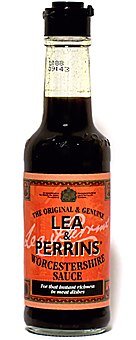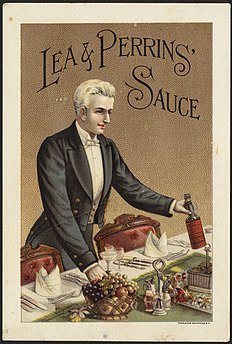British Heritage
Remember, Cherish, Learn.
beta
Lea & Perrins - the original Worcestershire Sauce
Embodiment of British Heritage through Worcestershire Sauce.
Lea & Perrins, an iconic brand that has indelibly etched its name into British culinary heritage, is a saga of more than two centuries of condiment craftsmanship. Synonymous with Worcestershire Sauce, the original recipe, a palatable secret brewed in the 1830s, still remains a quintessential component of numerous dishes and beverages around the globe.
The origins of Lea & Perrins are intertwined with the personal histories of two dispensing chemists, John Wheeley Lea and William Henry Perrins. In 1837, operating from their humble abode on Broad Street, Worcester, Lea and Perrins attempted to replicate a fish sauce for Marcus Sandys, the 3rd Baron Sandys, who had been captivated by its taste during his service in Bengal. Their initial effort resulted in a concoction so unpalatable that it was relegated to the cellar, only to be discovered after three years. To their astonishment, the neglected sauce had undergone a miraculous transformation, fermenting into a delectable Worcestershire sauce.
Today, this celebrated sauce is still produced in the historic Midland Road factory in Worcester, a testament to Lea and Perrins' enduring legacy. The factory, strategically located by the Midland Railway, facilitated the efficient import of raw materials and export of their increasingly popular sauce. This historical symbiosis between the factory and railway signifies not only the growth of Lea & Perrins but also the industrial development of Britain in the 19th century.
As the sauce's popularity transcended national boundaries, it soon found its way to the United States. Imported by the Duncan family of New York in 1839, the sauce established its enduring presence in American cuisine, and a subsidiary in Pittsburgh now manufactures an American variant of the recipe.
The British and American versions of Lea & Perrins Worcestershire Sauce vary slightly, reflecting the subtle nuances of local taste and dietary preferences. The UK variant utilises malt vinegar, while the American counterpart prefers distilled white vinegar. Furthermore, in a move acknowledging health concerns, the US recipe replaced high fructose corn syrup with sugar in 2011, aligning with the UK version's enduring use of sugar. This commitment to quality and consumer wellbeing further cements the brand's esteem.
The distinctive packaging of Lea & Perrins Worcestershire Sauce has become synonymous with the brand's identity. Known for its unique paper wrapper in the United States and a recognisable bottle shape with an orange and black label in the UK, these visual elements have contributed to its lasting consumer appeal.
Much of the sauce's allure lies in its closely guarded recipe. Although an original 19th-century list of ingredients was discovered in 2009 — featuring vinegar, molasses, sugar, salt, anchovies, tamarind extract, onions, garlic and other possible components like cloves, soy sauce, lemons, pickles, and peppers — the exact quantities and methods remain a cherished secret, adding to the mystical allure of the brand.
Since becoming a subsidiary of Kraft Heinz, Lea & Perrins has expanded its product line, particularly in the United States. Variations include a reduced-sodium version of the original sauce, a steak sauce, and marinades in flavours such as peppercorn and vinaigrette. However, the company continues to sell only a single variety of Worcestershire sauce in the UK and Canada, preserving the essence of the original recipe.
In conclusion, Lea & Perrins stands as a veritable institution in British culinary heritage, with its Worcestershire Sauce serving as a cherished emblem of this legacy. Its ongoing contribution to global cuisine ensures that the brand's influence continues to resonate worldwide, ensuring its place in the annals of culinary history.
A Tale of Two Chemists and an Unexpected Success
The origins of Lea & Perrins are intertwined with the personal histories of two dispensing chemists, John Wheeley Lea and William Henry Perrins. In 1837, operating from their humble abode on Broad Street, Worcester, Lea and Perrins attempted to replicate a fish sauce for Marcus Sandys, the 3rd Baron Sandys, who had been captivated by its taste during his service in Bengal. Their initial effort resulted in a concoction so unpalatable that it was relegated to the cellar, only to be discovered after three years. To their astonishment, the neglected sauce had undergone a miraculous transformation, fermenting into a delectable Worcestershire sauce.
Today, this celebrated sauce is still produced in the historic Midland Road factory in Worcester, a testament to Lea and Perrins' enduring legacy. The factory, strategically located by the Midland Railway, facilitated the efficient import of raw materials and export of their increasingly popular sauce. This historical symbiosis between the factory and railway signifies not only the growth of Lea & Perrins but also the industrial development of Britain in the 19th century.
A Global Ambrosia with Local Twists
As the sauce's popularity transcended national boundaries, it soon found its way to the United States. Imported by the Duncan family of New York in 1839, the sauce established its enduring presence in American cuisine, and a subsidiary in Pittsburgh now manufactures an American variant of the recipe.
The British and American versions of Lea & Perrins Worcestershire Sauce vary slightly, reflecting the subtle nuances of local taste and dietary preferences. The UK variant utilises malt vinegar, while the American counterpart prefers distilled white vinegar. Furthermore, in a move acknowledging health concerns, the US recipe replaced high fructose corn syrup with sugar in 2011, aligning with the UK version's enduring use of sugar. This commitment to quality and consumer wellbeing further cements the brand's esteem.
Symbolic Packaging, Secret Recipe
The distinctive packaging of Lea & Perrins Worcestershire Sauce has become synonymous with the brand's identity. Known for its unique paper wrapper in the United States and a recognisable bottle shape with an orange and black label in the UK, these visual elements have contributed to its lasting consumer appeal.
Much of the sauce's allure lies in its closely guarded recipe. Although an original 19th-century list of ingredients was discovered in 2009 — featuring vinegar, molasses, sugar, salt, anchovies, tamarind extract, onions, garlic and other possible components like cloves, soy sauce, lemons, pickles, and peppers — the exact quantities and methods remain a cherished secret, adding to the mystical allure of the brand.
Expanding the Culinary Legacy
Since becoming a subsidiary of Kraft Heinz, Lea & Perrins has expanded its product line, particularly in the United States. Variations include a reduced-sodium version of the original sauce, a steak sauce, and marinades in flavours such as peppercorn and vinaigrette. However, the company continues to sell only a single variety of Worcestershire sauce in the UK and Canada, preserving the essence of the original recipe.
In conclusion, Lea & Perrins stands as a veritable institution in British culinary heritage, with its Worcestershire Sauce serving as a cherished emblem of this legacy. Its ongoing contribution to global cuisine ensures that the brand's influence continues to resonate worldwide, ensuring its place in the annals of culinary history.
- Lea & Perrinsen.wikipedia.org








